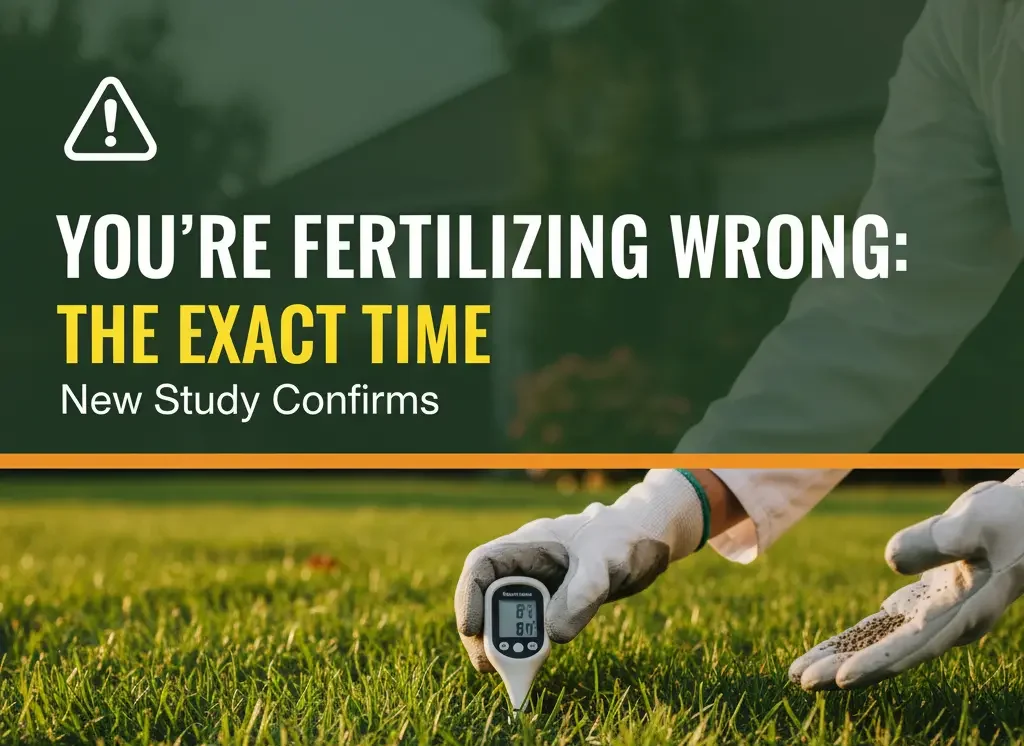You’re Fertilizing Wrong: New Study Confirms The Exact Time to Feed Grass

For years, homeowners have dutifully fertilized their lawns, often following generalized seasonal advice. But what if the timing you’ve been relying on is actually hindering, not helping, your grass? A groundbreaking new study is challenging conventional wisdom, revealing that the exact moment you feed your lawn is far more critical than previously understood. This research confirms that mistiming your fertilizer application can lead to wasted product, environmental runoff, and even a weaker, less resilient lawn. Stop guessing and discover the precise window that will transform your grass into the lush, vibrant green you’ve always wanted, according to the latest scientific findings.
The Common Fertilizing Mistakes & Why Timing is Everything
Most homeowners fertilize in spring for a quick green-up, and perhaps again in summer. While well-intentioned, this approach often misses the mark on what the grass truly needs and when it can best absorb nutrients.
Why Timing Matters More Than Quantity:
- Root Development vs. Top Growth: Applying nitrogen-rich fertilizer when grass is actively growing (hot summer) primarily promotes top growth, not deep root development. This leads to a weaker, less drought-tolerant lawn.
- Nutrient Absorption: Grass roots absorb nutrients most efficiently when soil temperatures are ideal, not just when the air is warm.
- Environmental Impact: Mis-timed fertilization can lead to excessive runoff, polluting waterways, and wasting your money.
- Disease Susceptibility: Over-fertilizing at the wrong time (e.g., too much nitrogen in late summer) can make your lawn more susceptible to fungal diseases.
The Groundbreaking Study: Unveiling the “Exact Time”
Recent research, focusing on cool-season and warm-season grasses across various climates, has pinpointed optimal fertilization windows based on soil temperature and growth cycles, rather than just calendar months. The study highlights that matching nutrient application to the grass’s specific metabolic needs is paramount.
Key Findings from the Study:
- Cool-Season Grasses (e.g., Fescue, Rye, Kentucky Bluegrass):
- Peak Fall Window: The most crucial feeding time is late fall (early October to mid-November in many regions), when air temperatures are cooling but soil temperatures are still above 50°F (10°C). This promotes robust root growth and energy storage for winter, leading to a strong spring emergence.
- Early Spring Boost (Secondary): A lighter application in early spring (March/April) can support initial green-up, but the fall feeding is foundational.
- Warm-Season Grasses (e.g., Bermuda, Zoysia, St. Augustine):
- Late Spring/Early Summer Peak: The best time is late spring to early summer (April to June), after the grass has fully emerged from dormancy and is actively growing. This fuels vigorous growth throughout its peak season.
- Late Summer (Secondary): A second, lighter application in late summer (July/August) can maintain vigor, but avoid fertilizing too late in fall.
The study emphasizes using slow-release nitrogen in these optimal windows to provide a steady supply of nutrients over time, preventing sudden growth surges and nutrient leaching.
How to Determine Your Lawn’s Exact Fertilizing Time
While the study provides general guidelines, local conditions vary. Here’s how to pinpoint the perfect time for your yard:
- Soil Temperature Monitoring: This is the most accurate method. Purchase a soil thermometer from a garden supply store. For cool-season grasses, aim for soil temperatures consistently between 50-65°F (10-18°C) in the fall. For warm-season grasses, aim for 65-80°F (18-27°C) in late spring/early summer.
- Observe Grass Growth: Pay attention to your lawn. Is it actively growing? Has it slowed down significantly? Is it starting to turn dormant? Fertilize when it’s actively growing and can best utilize the nutrients.
- Local Extension Office: Your local university extension office is an invaluable resource. They provide specific regional recommendations based on local climate, soil types, and grass varieties.
- Soil Test: Perform a soil test every few years. This tells you exactly what nutrients your soil is lacking, allowing you to choose the right fertilizer blend (e.g., high nitrogen, phosphorus, or potassium).
People Also Ask (PAA): Fertilization FAQs
Getting the timing right can be tricky. Here are answers to common questions about fertilizing:
Q1: When is the best time to fertilize lawn in fall?
For cool-season grasses, the best time to fertilize in fall is late fall (October to mid-November), when air temperatures are consistently cool but soil temperatures are still above 50°F (10°C). This promotes strong root growth and prepares the grass for winter.
Q2: How often should I fertilize my lawn?
The frequency depends on your grass type, climate, soil condition, and desired results. Generally, cool-season grasses benefit from 2-4 applications per year (fall being the most critical). Warm-season grasses usually do well with 2-3 applications during their active growing season (late spring/early summer). A soil test can provide precise recommendations.
Q3: What kind of fertilizer should I use for fall?
For cool-season grasses in the fall, a “winterizer” fertilizer high in potassium (K) is often recommended, as it helps strengthen roots and improves winter hardiness. Look for formulations like 10-0-20 or 12-4-8 (N-P-K ratios), often with a slow-release nitrogen component.
Q4: Should I fertilize before or after it rains?
It’s generally best to fertilize just before a light rain or to water your lawn lightly immediately after applying fertilizer. This helps the granules dissolve and move into the soil where the roots can absorb them, preventing “burn” on the grass blades. Avoid applying just before heavy rainfall, as it can lead to runoff and nutrient loss.
Stop Guessing, Start Growing: The Future of Lawn Fertilization
The era of one-size-fits-all fertilization is over. This new research provides a clear roadmap to a healthier, more vibrant lawn, not by using more product, but by applying it at the exact right time. By understanding your grass’s needs and aligning your fertilization schedule with natural growth cycles and soil temperatures, you can maximize nutrient uptake, minimize waste, and ensure your lawn thrives year-round. It’s time to fertilize smarter, not harder, and watch your Fit For Yard flourish.
To keep your lawn fit and beautiful all year round and to discover more invaluable tips, visit our Fit for Yard homepage and stay connected with our latest gardening news and updates.






